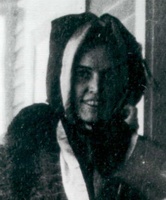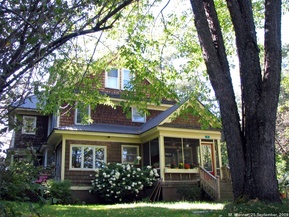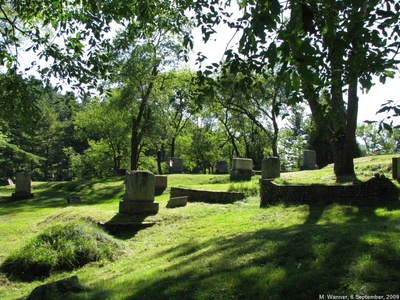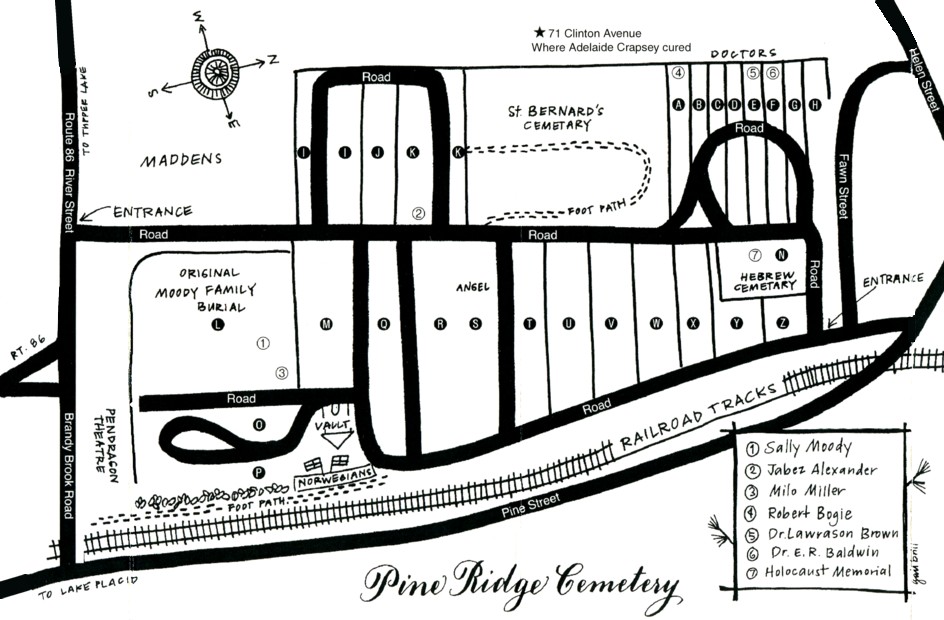 THE HISTORY AND SIGNIFICANCE of PINE RIDGE CEMETERY
THE HISTORY AND SIGNIFICANCE of PINE RIDGE CEMETERY
Pine Ridge Cemetery occupies approximately twelve acres of land northwest of the intersection of Pine Street and River Street in the village of Saranac Lake, New York, Town of North Elba. Pine Street is a segment of the old Northwest Bay Road that opened this part of the Adirondacks to settlement. The cemetery is a part of the farm of the Jacob Smith Moody family, Saranac Lake's first settlers, who arrived in 1819. The family chose a place on their farm not far from their house on River Street when the necessity arose. The Old Cemetery Knoll with its pine trees was given free for anyone to use who needed a burial spot. The cemetery was known as Moody Cemetery until 1916.
Pine Ridge encompasses the Moody family burial ground in Section L, the original St. Bernard's Cemetery, the Hebrew Memorial Cemetery (Section N), and the lots surrounding them. The oldest marked grave is that of young Mary Ann Reynolds (1835-1843), but there were likely other early graves whose markers have since disappeared. Sally Brown Moody, Jacob's wife, is the first family member known to be buried there, in 1852. Jacob Moody himself, a fifer in the Ninth New York Infantry in the War of 1812 who fought in the Battle of Plattsburgh, was buried there in 1862.
Milo Bushnell Miller (1842-1917), son of early settler Pliny H. Miller became a wealthy land speculator. His burial place is marked by an impressive monument. Jesse Corey (1819-1896), for whom the hamlet of Coreys is named, lies in the old part of the Moody family burial ground. Cortis Moody (1822-1902), the first settlers' child born in Saranac Lake, is also laid in the family plot, a stone's throw from his birthplace. There are now 112 Moodys and 63 Millers in Pine Ridge Cemetery.
By the mid-1800s, the Adirondacks were becoming a popular place to visit for recreation. At that time several large hotels were built. In 1852 the first hotel on Lower Saranac Lake was built by William F. Martin (1823-1892). He is buried in the old Moody Burial Ground. Soon after this, in the center of the village, the Berkeley Hotel was built by Charles Gray (1845-1883). The Riverside Inn on Main Street was a busy place run by Orlando Blood (1820-1900). All of those mentioned above are buried in Section L. In the late 1800s another hotel, the Algonquin, was built on Lower Saranac Lake by Jabez D. Alexander (1842-1916). He is buried in Section K.
From its founding in 1884, Dr. Edward Livingston Trudeau's growing sanatorium and the many tuberculosis patients and doctors it attracted caused tremendous growth in the village. In 1892 the Trudeau Sanatorium purchased burial lots in Pine Ridge for eight of their patients (Section L).
 Adelaide Crapsey, believed to have been taken in her room at 71 Clinton Avenue in the winter of 1913-14. From her nephew, Arthur Crapsey, via Karen Alkalay-Gut
Adelaide Crapsey, believed to have been taken in her room at 71 Clinton Avenue in the winter of 1913-14. From her nephew, Arthur Crapsey, via Karen Alkalay-Gut  The Adelaide Crapsey Cottage overlooks the cemetery In the village there was a demand for rooms for the increasing number of patients. Many homes became "cure cottages." In 1913-1914, the house at 39 Clinton Avenue on the hill to the west overlooking the cemetery was run by Miss R. Helen Lucy as a cure cottage. One patient in that cottage was a young woman who dubbed the cemetery "Trudeau's Garden." A poet who was just beginning to be published when T.B. took her life, Adelaide Crapsey wrote one of her most famous posthumously published poems: "To the Dead in the Graveyard Underneath My Window." To the single year she spent in Saranac Lake, Adelaide Crapsey owes her place in American letters. Like most patients whose cure was unsuccessful, she is not buried here, but went home to Rochester to die; the bodies of many others were shipped home on the night train from Union Depot.
The Adelaide Crapsey Cottage overlooks the cemetery In the village there was a demand for rooms for the increasing number of patients. Many homes became "cure cottages." In 1913-1914, the house at 39 Clinton Avenue on the hill to the west overlooking the cemetery was run by Miss R. Helen Lucy as a cure cottage. One patient in that cottage was a young woman who dubbed the cemetery "Trudeau's Garden." A poet who was just beginning to be published when T.B. took her life, Adelaide Crapsey wrote one of her most famous posthumously published poems: "To the Dead in the Graveyard Underneath My Window." To the single year she spent in Saranac Lake, Adelaide Crapsey owes her place in American letters. Like most patients whose cure was unsuccessful, she is not buried here, but went home to Rochester to die; the bodies of many others were shipped home on the night train from Union Depot.
By 1888 enough need had developed for a Catholic Cemetery to incorporate. In 1894 St. Bernard's parish acquired one and a half acres north of the Moody plots by deed from Elenora and Benjamin Moody, who reserved the right to cut hay on the new section, his former farm, in its first two years. In 1916, Pine Ridge Cemetery was incorporated and purchased the Moody Cemetery, also known as the Old Protestant Cemetery, from the family.
The Hebrew Memorial Cemetery (Section N) was dedicated in 1919 with 16 plots and was marked by a bronze plaque on the entry arch, though the oldest grave is dated 1915. A monument in this section memorializes the family members of Dr. and Mrs. Bartholomew Ring of Lake Placid; twenty-five of them were killed in concentration camps in Europe during the Holocaust. The inclusion of three faiths in one burial ground emphasizes the pluralistic nature of the village - rare for a remote, rural place - and Saranac Lake's acceptance of diversity at a time when Jews and Catholics were victims of discrimination elsewhere.
In May 1925, the cemetery corporation adopted plans drawn by the architectural firm of Scopes and Feustmann for a vault with a capacity of thirty for the winter storage of bodies for May burial, a common practice in northern climates where deep frost presents an obstacle to the opening of graves in winter. After the vault was completed, a new River Street entrance gateway was built: stone pillars and an iron arch with the name Pine Ridge Cemetery; it was later removed to widen the entranceway. Use of the hilly site depended upon terracing with stone walls; laid up in a variety of styles, they are a prominent feature of the cemetery landscape today.
Among the founding families, doctors, and their patients buried in Pine Ridge are two especially notable doctors, co-workers of Dr. Trudeau (who is buried at St. John's in the Wilderness in Paul Smiths). Both were T.B. patients themselves. Dr. Edward R. Baldwin, pioneer in tuberculosis research in the U.S., was director of the Saranac Laboratory until 1926; Adelaide Crapsey was his patient. Dr. Lawrason Brown was an internationally known tuberculosis specialist, director of the Trudeau Sanatorium, and the founder of the first sanatorium workshop of occupational therapy for T.B. patients. The Voluntary Health Association keeps The Pines, the hillside to the east of Pine Street, as a memorial to Dr. Brown, who died in 1937. Brown and Baldwin, who died ten years later, are buried near T.B. J. Woods Price, Hugh M. Kinghorn and Edward N. Packard, in the northwest corner, well worth visiting (Sections A - H).
Between the vault and the railroad tracks to the east are the graves of fifteen Norwegian seamen and the daughter of a merchant marine captain who were at sea in 1940 when the Nazis invaded Norway. Fleeing to the U.S., they were diagnosed with tuberculosis and sent to Saranac Lake to cure. These sixteen died between 1942 and 1945 but at least two others lived out long lives in Saranac Lake. Surrounded by a chain with anchors, a large stone reads, in translation, "In memory of the Norwegian seamen who died in the struggle to free their homeland." Another Norwegian, world famous scientist and explorer, Carl Lumholtz, who is honored with a statue in Lillehammer, Norway, died here in 1922 and is buried in Section W. Architect William Henry Scopes, a patient who came to specialize in the design of sanatoria as their medical requirements were developed at Trudeau Sanatorium, died in 1964 and was buried in Section B. In the village, his work with long-time partner Maurice Feustmann included the Reception Hospital, Harrietstown Town Hall, Hotel Saranac and Will Rogers Hospital.. This hospital was originally called the National Vaudeville Artists Lodge and was established and run for all workers in the entertainment industry. In 1940 they purchased burial plots in Pine Ridge Cemetery for eight of their former patients (Section T).
Pine Ridge Cemetery is a microcosm of the history of Saranac Lake from its earliest settlement in 1819, through its up-building period and the whole lifetime of the sanatorium (1884-1954) to the present day. There are approximately 400 veterans buried here representing every war since the War of 1812. Robert Bogie, a much-decorated World War II veteran, was buried in an old family lot in Section B. Others here of importance include: early photographer William L. Distin (Section D); guide and cure cottage developer Tom Peacock (Section R); 1932 Olympic bobsledder Hubert Stevens (Section Q); wealthy patient Dr. Joseph Nichols and his wife Mary Morgan Nichols (Section G); and the Hanmers, a family of guideboat builders (Section S). Three benefactors of the cemetery, whose early families were prominent citizens of Saranac Lake, are James Collins (Section V), Albert Evans (Section D), and Patricia Harvey, a descendant of the Hogan family (Section K).
More than five thousand people are buried in Pine Ridge Cemetery, including many T.B. patients from around the world in unmarked graves. Early photographer William L. Distin, guide and cure cottage developer Tom Peacock, guideboat builder Theodore Hanmer, patient Dr. Joseph Nichols and his wife, Mary Morgan Nichols, patient James Spencer Lamar, whose health failed when he attempted to join Troop B of the State Police — together with the hundreds of others buried in Pine Ridge, they represent the broad range of Saranac Lake's cosmopolitan population. Pine Ridge Cemetery is still in use.
Written by Mary B. Hotaling. Copyright - Historic Saranac Lake 2012.
Lake Placid News, April 7, 1916
The first meeting of directors of the Pine Ridge Cemetery, Inc., which has taken over what was formerly Moody Cemetery, was held at the Adirondack National Bank Building last week. Organization was effected and several important matters disposed of, among which was the purchase from B. R. Moody of the balance of his land adjoining the present cemetery.
Thank you for overseeing the upkeep of the cemetery: Michael Madden, Natalie Leduc, Kathryn Peightal, Kathy Merritt and Rodger Dempster.
Take a tour through Pine Ridge Cemetery with Natalie Leduc! Video produced by Josh Clement and Ed Kanze.
The cemetery is owned by an association. Anyone who has family buried here, or who owns a lot, is a member. The annual meeting of the association will be held Thursday, April 15, 2010, at 5 p.m. at the North Elba Town House on River Street. For more information, call a member of the Pine Ridge Cemetery Association at 518 891-4256 or 518 891-4781.
| For lists of burials, see: | A | B | C | D | E | F | G | H | I-J | K | L | M | N | O | P | Q-R | S | T | U-V | W | XYZ |
Codes used in the burial records:
| St B | St Bernard’s section of cemetery |
| OO | unknown location in the cemetery |
| BR | death certificate obtained from the village office |





